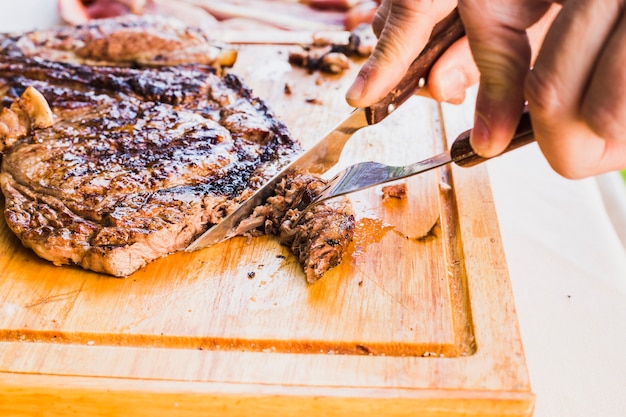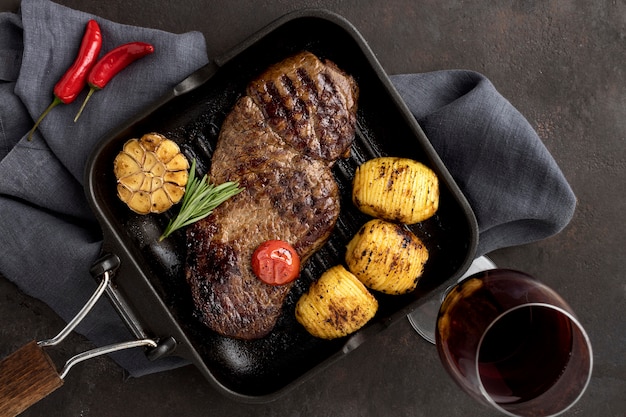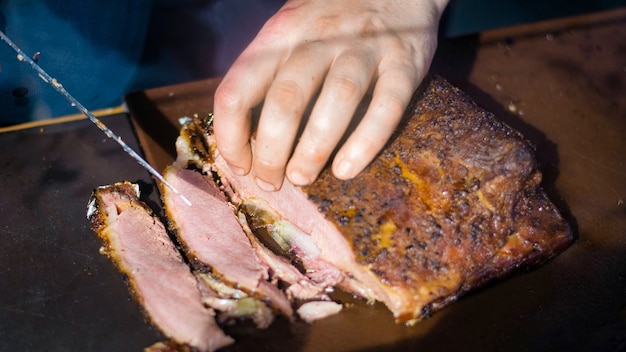Ah, sirloin steak. The king of the grill, the star of countless Sunday dinners, and the source of countless happy sighs. It's a cut of meat that holds a special place in my heart, and I've spent years perfecting my methods for cooking it to utter deliciousness.
This isn't just any old guide, though. This is a journey into the heart of the sirloin, an exploration of the nuances that make this cut so special. We'll delve into the art of choosing the right cut, master the techniques that bring out its best qualities, and discover the secrets to achieving that perfect, juicy, flavour-bursting bite. So grab your apron, a good bottle of something red, and let's get started!
(Part 1) Choosing the Right Cut: The Foundation of a Great Steak

Understanding the Sirloin Family: Not All Sirloins Are Created Equal
Alright, let's start with the basics. The word "sirloin" isn't a single cut, but rather a family of cuts. You've got your top sirloin, bottom sirloin, tri-tip, and even the occasional center-cut. Each has its own unique characteristics and, let's be honest, it can be a bit confusing.
Let me break it down for you. Top sirloin, for example, comes from the upper part of the loin and is known for its tender texture and marbling. Bottom sirloin, on the other hand, is a bit leaner and often has a more pronounced grain. Tri-tip, a triangular cut from the bottom sirloin, is famous for its juicy flavour. And then you have center-cut, which comes from the center of the sirloin and boasts a uniform, even texture.
What Makes a Great Sirloin: Looking for the Perfect Cut
Choosing the right sirloin is the first step towards achieving that perfect steak. Here's what to look for:
Marbling: Look for a cut with good marbling, those beautiful white streaks of fat that run through the muscle. This fat doesn't just add flavour; it also keeps the steak moist and juicy during cooking. Think of it as nature's internal basting system.
Thickness: You want a cut that’s at least an inch thick. Any thinner and it will dry out too easily. A good rule of thumb is to aim for a steak that's about 1.5 inches thick for optimal results.
Colour: The colour of a sirloin can tell you a lot. Look for a cut that's evenly coloured, with a rich, dark red hue. Avoid any discolouration, bruising, or areas that look dry.
My Picks: The Cuts I Trust for That Perfect Bite
When I’m looking for a sirloin steak that’s guaranteed to deliver, I go for a thick-cut top sirloin. It's a reliable choice, offering a good balance of tenderness and flavour. Plus, it holds its shape beautifully during cooking.
But honestly, there’s no right or wrong answer here. It's all about personal preference. Maybe you love the leanness of bottom sirloin, or perhaps you're a fan of the unique flavour of tri-tip. The key is to find the cut that makes your heart sing and your taste buds dance.
(Part 2) Getting Ready to Cook: The Art of Preparation

The Secret to Tenderness: Bringing the Steak to Room Temperature
Here's a tip that makes a world of difference. Don't just grab your steak straight from the fridge and throw it on the grill. Let it sit at room temperature for about 30 minutes. This allows the steak to even out in temperature, ensuring that it cooks more evenly and results in a more tender, juicy outcome.
Seasoning Like a Pro: The Simplicity of Salt and Pepper
I believe in keeping things simple when it comes to seasoning. Salt and pepper – that’s all you really need. And use good quality ingredients. I like to use kosher salt for its larger grain, which dissolves beautifully and creates a more even seasoning. And always use freshly ground black pepper. The difference is incredible.
Don't Be Shy: Embracing the Power of Seasoning
Don't be afraid to season generously. It's not about covering the flavour of the steak; it's about enhancing it. Give it a good rub all over, making sure every inch is coated.
Don't Forget the Fat: A Key Ingredient for Flavor and Juiciness
The fat in a sirloin steak is your best friend. It adds flavour, keeps the meat moist, and helps create that beautiful golden crust. Don't trim it all off! Leave a good layer of fat on the steak, especially around the edges. You'll thank me later.
(Part 3) Mastering the Art of Grilling: The Hottest Way to Cook

The Heat Is On: Getting That Grill Ready
When it comes to grilling, I’m a true believer in high heat. Forget those timid, lukewarm grills. We want a roaring fire! Get those coals glowing red-hot, or if you're using a gas grill, preheat it to the highest setting. We're talking scorching heat, my friend.
Sealing in the Flavor: The Importance of That First Sear
That initial sear is absolutely crucial. It's what gives your steak that beautiful, crispy crust and locks in all the juicy goodness. Place your steak on the hot grill, and don't move it for at least 2-3 minutes. Let it get a nice, even sear on one side before you even think about flipping it.
Rotating for Even Cooking: Achieving Those Perfect Grill Marks
Once you have a beautiful sear on one side, it's time to rotate the steak 90 degrees. This will help you achieve those gorgeous crosshatch grill marks, a mark of a true grilling pro. Keep rotating and flipping the steak every 2-3 minutes, ensuring that all sides get a good sear.
The Danger of Overcooking: Respecting the Perfect Doneness
Here's where things get a bit tricky. You want to cook your steak to your desired level of doneness, but the key is to avoid overcooking. Overcooked sirloin can become tough, dry, and, frankly, a bit of a disappointment.
(Part 4) Achieving the Perfect Level of Doneness: Knowing When It's Ready
Understanding the Levels: From Rare to Well-Done
You've heard the terms, but what do they really mean? "Rare," "medium-rare," "medium," "medium-well," and "well-done" all refer to the internal temperature of the steak.
Rare: A rare steak has a cool, red center with a thin, cooked outer layer. It's the least cooked level, and the internal temperature should be around 125°F (52°C).
Medium-rare: This is the sweet spot for many steak lovers. The center is pink and juicy, with a slightly warmer outer layer. It should register around 130°F (54°C).
Medium: A medium steak has a slightly pink center with a cooked exterior. The internal temperature reaches 140°F (60°C).
Medium-well: The center of the steak is brown with a touch of pink, and it's mostly cooked through. The internal temperature is about 150°F (65°C).
Well-done: A well-done steak is completely brown throughout, with no hint of pink. It's the most cooked level, and the internal temperature should reach 160°F (71°C).
The Reliable Guide: Using a meat thermometer
I always use a meat thermometer to make sure my steak is cooked to perfection. It's simply the most reliable way to ensure that the steak reaches the desired internal temperature.
The Touch Test: A Helpful Alternative (But Not Always Perfect)
If you don't have a meat thermometer, you can try the touch test. It's not as accurate, but it can give you a general idea of the doneness. Gently press your finger on the center of the steak.
Rare: Feels soft and jiggly
Medium-rare: Feels springy
Medium: Feels firm
Medium-well: Feels very firm
Well-done: Feels hard
My Personal Preference: The Juicy World of Medium-rare
As for me, I'm a big fan of medium-rare. It's the perfect balance of tenderness, juiciness, and flavour. But hey, this is about you. Go with whatever level of doneness makes your heart happy.
(Part 5) The Importance of Resting: Let the Juices Redistribute
Why It Matters: A Crucial Step for Tenderness
This is a crucial step that many people overlook. Once your steak is cooked to perfection, don't just slice it up immediately. Let it rest for 5-10 minutes before you touch it. This allows the juices to redistribute throughout the steak, creating a more tender and juicy result.
How to Rest a Steak: The Perfect Setup
I like to rest my steak on a cutting board, loosely covered with foil. This keeps it warm while it rests and prevents it from drying out.
(Part 6) Delicious Sides for Your Perfect Steak: The Ultimate Accompaniments
The Classic Pairing: Steak and Potatoes, a Match Made in Heaven
Steak and potatoes. It's a classic pairing for a reason. It’s simple, satisfying, and utterly delicious. I’m a fan of roasted potatoes, but you can also go for mashed potatoes, potato wedges, or even fries.
Going Green: The Freshness of a Salad
A side of something green is essential for me. It balances out the richness of the steak and adds a refreshing contrast. A simple salad is perfect, but you can also try asparagus, broccoli, or even grilled zucchini.
Exploring Beyond the Basics: Expanding Your side dish Horizons
If you're feeling adventurous, the possibilities for steak sides are endless. Roasted vegetables, grilled corn on the cob, creamy mushroom sauce, or even a vibrant chimichurri sauce – the choice is yours!
(Part 7) Finishing Touches: Elevating Your Steak to New Heights
A Touch of Butter, Herbs, and Garlic: Adding a Burst of Flavor
I like to add a little something extra to my steak just before serving. A pat of butter, a sprinkle of fresh herbs like rosemary or thyme, or a clove of garlic can really elevate the flavour. It’s a simple touch that makes all the difference.
A Splash of Sauce: Taking Things to the Next Level
If you want to go the extra mile, consider making a simple sauce to go with your steak. A red wine sauce is always a classic choice. Or try a creamy mushroom sauce or a peppery chimichurri sauce. You can find countless delicious sauce recipes online.
(Part 8) The Art of Slicing: Achieving Perfect PresentationCutting Against the Grain: A Key to Tenderness
Finally, it's time to slice your steak. This is where many people make a mistake. Cut your steak against the grain. This means slicing across the muscle fibers, which makes the steak more tender and easier to chew. Imagine slicing a loaf of bread – you wouldn’t slice it along the length, right?
Slicing It Right: Presentation Matters
I like to slice my steak into thin pieces, about 1/4 inch thick. It's easier to eat and looks more elegant.
(Part 9) Serving and Enjoying: The Final Act
The Perfect Plate: Presentation Makes a Difference
Now it’s time to plate up your masterpiece. I like to put my sliced steak on a warm plate, and then arrange my sides around it. A sprig of rosemary or a drizzle of sauce can add a touch of elegance.
The Moment of Truth: Take a Bite, Savour the Flavour
And finally, the moment we’ve all been waiting for. Take a bite of your perfectly cooked steak and savour every moment. Let the flavours dance on your tongue, and appreciate the hard work that went into creating this culinary masterpiece.
FAQs
1. What is the best type of sirloin steak to buy?
It depends on your personal preference, but a thick-cut top sirloin is a reliable choice for its tenderness, flavour, and ability to hold its shape.
2. How long should I cook a sirloin steak?
The cooking time varies depending on the thickness of the steak and your desired level of doneness. However, always start with a hot grill and cook for about 2-3 minutes per side.
3. What happens if I overcook my sirloin steak?
Overcooked sirloin can become tough, dry, and a bit chewy. Aim for your desired level of doneness, but don't overcook it.
4. How do I know when my sirloin steak is done?
The most reliable method is to use a meat thermometer. If you don’t have one, you can try the touch test, but it's not as accurate.
5. What are some good sides to serve with sirloin steak?
Steak is delicious with countless sides. Classic choices include roasted potatoes, mashed potatoes, or a simple salad. Get adventurous with roasted vegetables, grilled corn on the cob, creamy mushroom sauce, or even chimichurri sauce. The possibilities are endless!
Everyone is watching

How to Cook Frozen Lobster Tails Perfectly: A Step-by-Step Guide
RecipesLobster. Just the word conjures up images of lavish meals, special occasions, and a taste of luxury. But let's...

Pigs in a Blanket Cooking Time: How Long to Bake for Perfect Results
RecipesAh, pigs in a blanket. Just the name conjures up images of those delightful little parcels of crispy pastry en...

Pork Fillet Cooking Time: How Long to Cook It Perfectly
RecipesPork fillet, or tenderloin as it's sometimes called, is a real favourite in our house. It's so versatile, and...

The Ultimate Guide to Cooking Delicious Frankfurters
RecipesLet's face it, we all love a good frankfurter. It's a classic, simple, and always satisfying. But let's be rea...

Wolf Meat Recipes: A Guide to Cooking Wild Game
RecipesLet's be honest, you don't see wolf meat at your local butcher shop every day. It's a bit of a wild card, but ...
